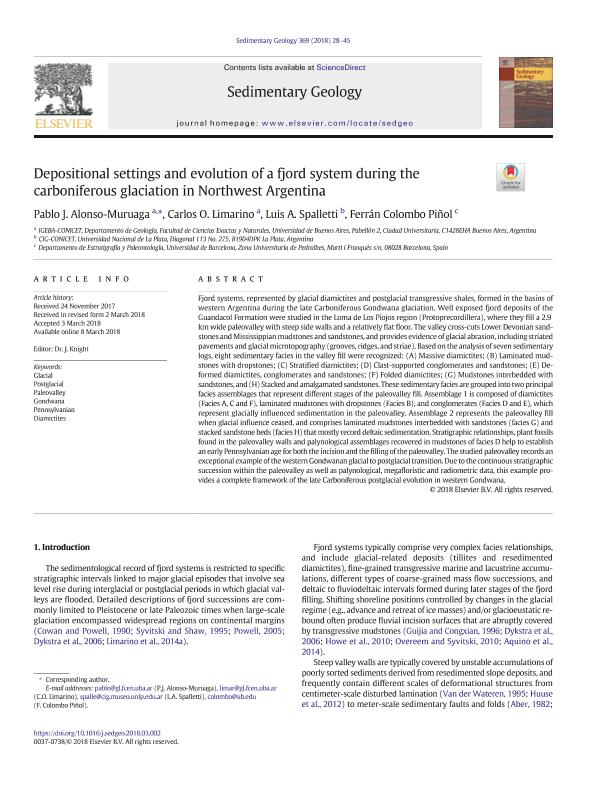Artículo
Depositional settings and evolution of a fjord system during the carboniferous glaciation in Northwest Argentina
Alonso Muruaga, Pablo Joaquin ; Limarino, Carlos Oscar
; Limarino, Carlos Oscar ; Spalletti, Luis Antonio
; Spalletti, Luis Antonio ; Colombo Piñol, Ferran
; Colombo Piñol, Ferran
 ; Limarino, Carlos Oscar
; Limarino, Carlos Oscar ; Spalletti, Luis Antonio
; Spalletti, Luis Antonio ; Colombo Piñol, Ferran
; Colombo Piñol, Ferran
Fecha de publicación:
07/2018
Editorial:
Elsevier Science
Revista:
Sedimentary Geology
ISSN:
0037-0738
Idioma:
Inglés
Tipo de recurso:
Artículo publicado
Clasificación temática:
Resumen
Fjord systems, represented by glacial diamictites and postglacial transgressive shales, formed in the basins of western Argentina during the late Carboniferous Gondwana glaciation. Well exposed fjord deposits of the Guandacol Formation were studied in the Loma de Los Piojos region (Protoprecordillera), where they fill a 2.9 km wide paleovalley with steep side walls and a relatively flat floor. The valley cross-cuts Lower Devonian sandstones and Mississippian mudstones and sandstones, and provides evidence of glacial abrasion, including striated pavements and glacial microtopography (grooves, ridges, and striae). Based on the analysis of seven sedimentary logs, eight sedimentary facies in the valley fill were recognized: (A) Massive diamictites; (B) Laminated mudstones with dropstones; (C) Stratified diamictites; (D) Clast-supported conglomerates and sandstones; (E) Deformed diamictites, conglomerates and sandstones; (F) Folded diamictites; (G) Mudstones interbedded with sandstones, and (H) Stacked and amalgamated sandstones. These sedimentary facies are grouped into two principal facies assemblages that represent different stages of the paleovalley fill. Assemblage 1 is composed of diamictites (Facies A, C and F), laminated mudstones with dropstones (Facies B), and conglomerates (Facies D and E), which represent glacially influenced sedimentation in the paleovalley. Assemblage 2 represents the paleovalley fill when glacial influence ceased, and comprises laminated mudstones interbedded with sandstones (facies G) and stacked sandstone beds (facies H) that mostly record deltaic sedimentation. Stratigraphic relationships, plant fossils found in the paleovalley walls and palynological assemblages recovered in mudstones of facies D help to establish an early Pennsylvanian age for both the incision and the filling of the paleovalley. The studied paleovalley records an exceptional example of the western Gondwanan glacial to postglacial transition. Due to the continuous stratigraphic succession within the paleovalley as well as palynological, megafloristic and radiometric data, this example provides a complete framework of the late Carboniferous postglacial evolution in western Gondwana.
Palabras clave:
Diamictites
,
Glacial
,
Gondwana
,
Paleovalley
,
Pennsylvanian
,
Postglacial
Archivos asociados
Licencia
Identificadores
Colecciones
Articulos(CIG)
Articulos de CENTRO DE INVEST.GEOLOGICAS (I)
Articulos de CENTRO DE INVEST.GEOLOGICAS (I)
Articulos(IGEBA)
Articulos de INSTITUTO DE GEOCIENCIAS BASICAS, APLICADAS Y AMBIENTALES DE BS. AS
Articulos de INSTITUTO DE GEOCIENCIAS BASICAS, APLICADAS Y AMBIENTALES DE BS. AS
Citación
Alonso Muruaga, Pablo Joaquin; Limarino, Carlos Oscar; Spalletti, Luis Antonio; Colombo Piñol, Ferran; Depositional settings and evolution of a fjord system during the carboniferous glaciation in Northwest Argentina; Elsevier Science; Sedimentary Geology; 369; 7-2018; 28-45
Compartir
Altmétricas



